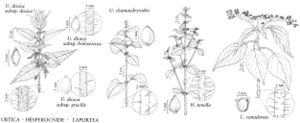Revision as of 21:50, 5 November 2020 by imported>Volume Importer
Stems hispid, with stinging hairs. Leaf blades abaxially hispid, both surfaces with stinging hairs. Flowers unisexual, staminate and pistillate on different plants. 2n = 52.
Phenology: Flowering late spring–early fall.
Habitat: Alluvial woods, margins of deciduous woodlands, fencerows, waste places
Elevation: 0-500 m
Distribution
Introduced; Greenland, St. Pierre and Miquelon, B.C., N.B., Nfld. and Labr. (Nfld.), N.S., Ont., P.E.I., Que., Ala., Alaska, Calif., Conn., Del., D.C., Fla., Ga., Maine, Md., Mass., Mich., Mo., N.H., N.J., N.Y., N.C., Ohio, Okla., Oreg., Pa., Tenn., Va., Wash., W.Va., native to Eurasia.
Discussion
No documented specimens of Urtica diocia var. dioica are known from Vermont; it could occur there in similar habitats.
Selected References
None.
Lower Taxa
None.
... more about "Urtica dioica subsp. dioica"
Greenland +, St. Pierre and Miquelon +, B.C. +, N.B. +, Nfld. and Labr. (Nfld.) +, N.S. +, Ont. +, P.E.I. +, Que. +, Ala. +, Alaska +, Calif. +, Conn. +, Del. +, D.C. +, Fla. +, Ga. +, Maine +, Md. +, Mass. +, Mich. +, Mo. +, N.H. +, N.J. +, N.Y. +, N.C. +, Ohio +, Okla. +, Oreg. +, Pa. +, Tenn. +, Va. +, Wash. +, W.Va. + and native to Eurasia. +
Present +
true +
Sp. Pl. +
1753 +
Urtica dioica subsp. dioica +
Urtica dioica +
subspecies +
